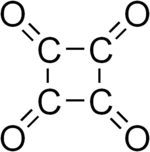Cyclobutanetétrone
| Cyclobutanetétrone | |

| |
| Identification | |
|---|---|
| Nom UICPA | cyclobutane-1,2,3,4-tétrone |
| Synonymes |
tétroxocyclobutane |
| No CAS | |
| SMILES | |
| InChI | |
| Propriétés chimiques | |
| Formule | C4O4 [Isomères] |
| Masse molaire[1] | 112,040 4 ± 0,004 4 g/mol C 42,88 %, O 57,12 %, |
| Unités du SI et CNTP, sauf indication contraire. | |
| modifier |
|
La cyclobutanetétrone aussi appelée tétroxocyclobutane est un composé organique de formule C4O4 ou (-(C=O)-)4 et consiste en la quadruple cétone du cyclobutane. Ce serait aussi un oxyde de carbone, le tétramère du monoxyde de carbone.
Cependant, ce composé semble être thermodynamiquement instable[2]. En 2000, il n'a pas encore été synthétisé en quantité significative[3],[4] mais a une existence transitoire, détectée par spectrométrie de masse[5].
Composés apparentés
[modifier | modifier le code]La cyclobutanetétrone peut être vue comme l'équivalent neutre de l'anion squarate, C4O42− qui est stable et est connu depuis au moins 1959[6].
Le composé octahydroxycyclobutane ou cyclobutane-1,1,2,2,3,3,4,4-octol, (-C(OH)2-)4 peut être mentionné dans la littérature comme "hydrate de tétraoxocyclobutane"[7].
Notes et références
[modifier | modifier le code]- (en) Cet article est partiellement ou en totalité issu de l’article de Wikipédia en anglais intitulé « Cyclobutanetetrone » (voir la liste des auteurs).
- Masse molaire calculée d’après « Atomic weights of the elements 2007 », sur www.chem.qmul.ac.uk.
- Haijun Jiao, Gilles Frapper, Jean-François Halet, and Jean-Yves Saillard, Stability of Tetraoxocyclobutane Revised: Perturbation Theory and Density Functional Scheme, J. Phys. Chem. A, 2001, vol. 105(24), pp. 5945–5947. DOI 10.1021/jp010738i.
- Mordecai B. Rubin and Rolf GleiteR, The Chemistry of Vicinal Polycarbonyl Compounds, Chemical Reviews, 2000, vol. 100(3), pp. 1121–1164. DOI 10.1021/cr960079j.
- (en) Gunther Seitz, « Oxocarbons and pseudooxocarbons », Chemical Reviews, vol. 92, no 6, , p. 1227–1260 (DOI 10.1021/cr00014a004, lire en ligne)
- (en) Detlef Schröder,, « Mass spectrometric studies of the oxocarbons CnOn (n = 3–6) », International Journal of Mass Spectrometry, vol. 188, nos 1–2, , p. 17–25 (DOI 10.1016/S1387-3806(98)14208-2)
- Sidney Cohen, John R. Lacher, Joseph D. Park, Diketocyclobutanediol, Journal of the American Chemical Society, 1959, vol. 81, p. 3480. DOI 10.1021/ja01522a083.
- S. Skujins, J. Delderfield and G. A. Webb, A mass spectrometric study of some monocyclic polycarbonyl compounds, Tetrahedron, 1967, vol. 24(13), pp. 4805–4817. DOI 10.1016/S0040-4020(01)98676-4.
- G. Maahs, P. Hegenberg, Syntheses and Derivatives of Squaric Acid, Angewandte Chemie Int. Ed., 2003, vol. 5(10), pp. 888–893. DOI 10.1002/anie.196608881.